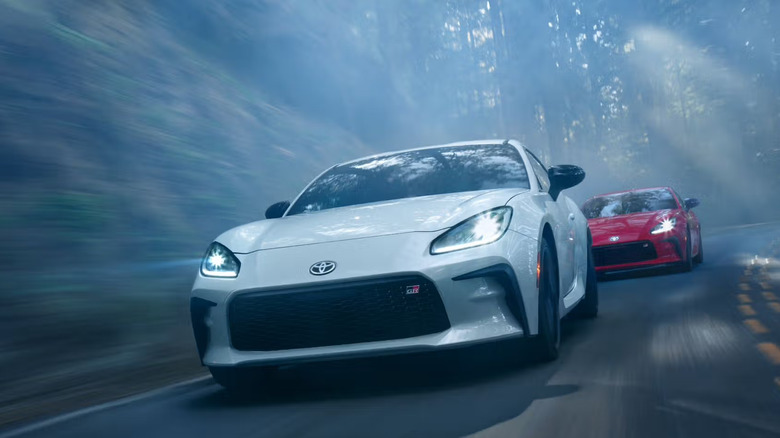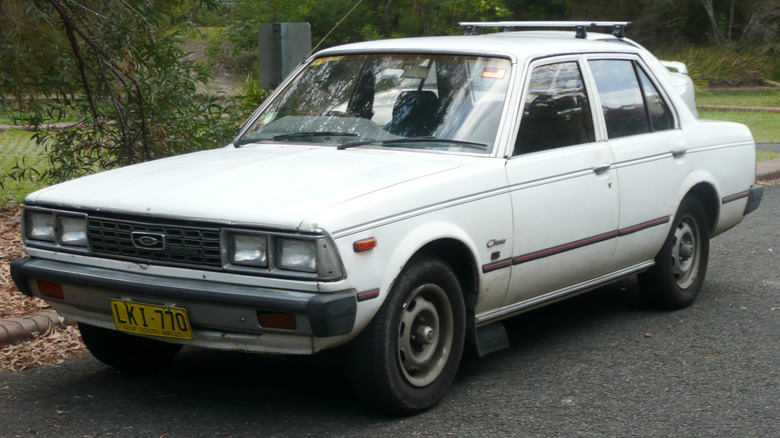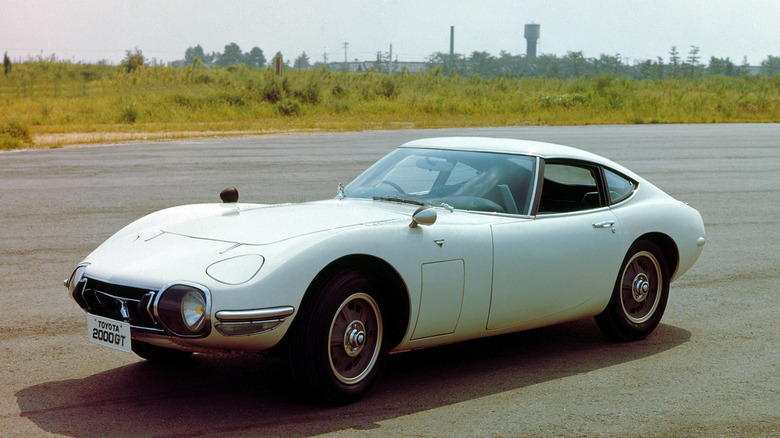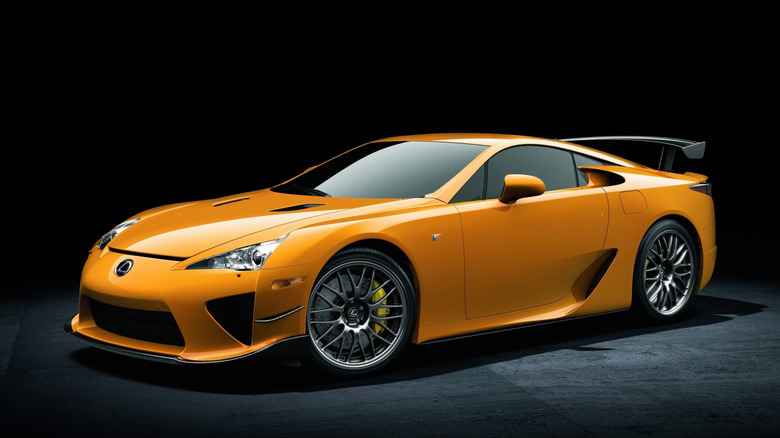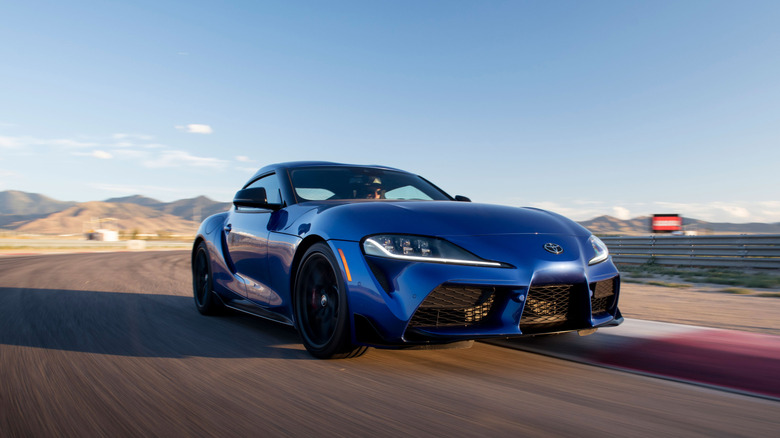5 Toyota Models With Non-Toyota Engines
Toyota represents one of the largest consumer goods manufacturers on the planet, a title earned largely through its reputation for producing dependable, low-maintenance cars and trucks for almost a century now. However, Toyota incorporates technology from all over the world into its cars, thanks to the Japanese firm owning other various brands or having stakes in them. Sometimes Toyota even uses other companies' engines under license, or produces complete cars in cooperation with other firms. For instance, Europe's early Toyota Aygo diesel uses a 1.4L Ford Europe/Peugeot engine. Likewise, some Toyota Yaris models are just rebadged Mazda2 hatchbacks and sedans equipped with Mazda engines.
We'd be here all day listing off all the cars badge-engineered by Toyota, with several models by Suzuki, Daihatsu, and more. Therefore, rather than looking at these cars, we'll instead focus on cars that are distinctively Toyota-bodied, or built from the ground-up in collaboration with other manufacturers. This list dates back a remarkable amount of time; in fact, the company's very first production engine was based on a "stovepipe" Chevrolet straight-six and used in its general-purpose trucks and buses like the Toyoda Model G1.
While many manufacturers adopt Toyota engines for their own usage, it's these Toyota examples with foreign engines that seldom get discussed, outside of a few notable cases we'll cover, along with a couple oddballs. We'll list them by the Toyota model, followed by the original manufacturer of its factory engine. Let's take a look at a few examples from least to most well-known in the greater automotive community, starting with a Toyota that actually legally had to feature a foreign-built engine, or face punitive tariffs.
Toyota Corona (Australia): General Motors/Holden
This is a rather interesting case, because the first-generation Australian Corona is a Toyota produced in an Australian plant. As such, it had to meet a specific requirement set in the mid-1970s that 85% of a vehicle's total value must be accounted-for with indigenous components. That means that this 1979-1983 model Toyota came at a time when it wouldn't have been allowed in Australian dealerships without the vast majority of the car assembled in Australia or imported from Japan. The best way to circumvent that was apparently to shove a 1.9L Holden Starfire engine with a few light modifications under the hood/bonnet.
So how did one of the most important Toyotas ever created gain a Holden engine in the late '70s? In-short, the reason why this decision was more lucrative was because of the steep tariffs, to the tune of over 50% on completed vehicles, imported to Australia at the time. Importing the engine would've presumably placed the Corona above the 85% threshold and classified the car as an import.
The Holden Starfire engine itself suffered from a poor reputation of being unreliable, leading to the unfortunate nickname "Holden Misfire." Various Holdens used the engine in the late-1970s to 1980s, its name derived from the classic Oldsmobile Starfire full-size and later compact cars. The Australian-production Toyota Corona used this engine until 1982, when the car was replaced with the next-generation Corona, which dropped the Starfire entirely. As for the tariffs, they were eventually lifted in 1985, having stimulated domestic Australian vehicle production enough to reintroduce foreign-built vehicles again.
Toyota 2000GT: Yamaha
Widely regarded as Japan's first supercar, the Toyota 2000GT represents arguably the zenith of Japanese automotive design in the 1960s, alongside other outstanding hand-built machines like the Mazda Cosmo and first-generation Nissan Silvia of a similar era. There are several factors which make the 2000GT so special, ranging from the utterly gorgeous bodywork, grand piano-wood dashboard interior, and European grand-touring proportions, to the handling characteristics good enough to serve as a platform for Carroll Shelby's SCCA career. Even with all of these considerations, one of the highlights remains the original 2.0L straight-six under that expansive hood-line.
The story of Toyota's collaboration with Yamaha began in 1964, during which Toyota tasked itself with developing the basic chassis architecture, bodywork, and the engine's fundamentals. The general bodywork was actually based on a prior prototype, the Yamaha A550X, and the engine itself derived from a more rudimentary SOHC design seen in the Toyota Crown. Yamaha then modified the powerplant with a brand-new upper using cutting-edge technology for the time, including an aluminum-alloy DOHC head and valvetrain and three Mikuni-Solex carburetors, producing a total of 150 horsepower from 2.0L. In addition, Yamaha also improved the suspension geometry and running-gear, culminating in the first Japanese sports car spoken in the same breath as famous grand-tourers like Jaguar, Maserati, and Ferrari.
Most 2000GTs featured this Yamaha-developed straight-six, with the exception of nine so-called "MF-12" variants featuring a SOHC 2.3L engine. In total, only 337 production examples ever left Toyota's factory at a rate of a mere eight cars per month, making this also one of the rarest regular-production Toyotas ever built.
Lexus LFA: Yamaha
The Lexus LFA is sometimes viewed as the true spiritual successor to the 2000GT by third-party sources, and both models are occasionally showcased by Toyota side-by-side at public events. It's easy to see where those comparisons come from: both are hand-built Japanese grand-touring supercars with a number of similarities, ranging from its racing pedigree to its outrageous levels of technology for its time. However, the most apparent connection both of these legendary models share is the developer of the LFA's outstanding V10 engine. An engine which, like the 2000GT before it, proudly boasts Yamaha's name.
The 1LR-GUE housed in the LFA is a high-revving 4.8L 10-cylinder powertrain mated to a six-speed sequential manual gearbox; it's this engine which arguably made the LFA into the legend it is today. Yamaha likened the exhaust note to the roar of an angel, building an entire line dedicated to hand-fitting just one engine per day for the slated production run of 500 units. Yamaha's development extends down to its experience in audio engineering, using this expertise to meticulously craft the engine note in the same way that the company views a musical instrument.
Effectively, Toyota gave Yamaha a blueprint and Yamaha sculpted this until it produced the incredible sound we know and love the LFA for today, right down to using specific RPMs to register finely-tuned harmonics. The LFA has its own incredible story to tell, with its tale beginning unlike any other Lexus model prior to it: on the racetrack, with the LF-A prototype competing in endurance racing before the first production model even left the factory.
The Subaru BRZ, Scion FR-S, and Toyota 86: Subaru
This marks likely the most visible car today when it comes to overtly-shared design architecture between Toyota and another company. The Subaru BRZ and Toyota 86 are identical in nearly every detail, save for some minor cosmetic differences, but underneath the skin rests the same platform, powertrain, and running-gear.
Following the demise of the Supra, MR-2, and MR-S, all Toyotas were subsequently built on a front-wheel drive platform, necessitating the creation of an entire new rear-wheel drive design specifically for the 86, originally known as the GT86. Toyota's outline required three factors: rear-wheel drive, naturally-aspirated, and ordinary passenger-car tires, along with minimal electronic aids. In essence, it was a car outright designed as a basic, budget-friendly, driver-centric, modestly-powered sports car, in the same vein as its namesake, the Toyota AE86 Corolla — hence the name Toyota GR86.
Because this car was built in collaboration with Subaru, the GT86 featured the iconic boxer-type engine from the likes of the Impreza and others, however it was its own proprietary design. Codenamed the "FA," this 2.0L 200-horsepower engine represented the bulk of Subaru's contributions, with the body housing it designed in-house by Toyota. In fact, Toyota cited the 2000GT as an early design inspiration, with the GT86 itself being a similarly-proportioned 2+2 sports coupe, albeit built in a far more accessible package. Believe it or not, the GT86 wasn't actually Toyota's first boxer-type engine, however; that title goes to the Sports 800, equipped with a modest 28-horsepower air-cooled flat-twin.
Toyota Supra (Mark V): BMW
This marks perhaps one of the most infamous Toyotas in recent memory for a variety of reasons. This ranged from not featuring any manual transmission option at launch, its styling too outlandish, and its price-point too expensive compared to what came before. But more than anything, it received a mountain of hate for its BMW-derived engine and platform, leading some to label the Mark V Supra a BMW instead of a Toyota.
The B58 engine housed within the modern Supra is virtually-identical to the one found in its sister car, the BMW Z4. Coupled with the shared platform architecture, and this car straddles the line between what's considered "badge-engineered," though its bodywork and interior appointments are generally distinctive enough that no one would mix the two up if you removed their respective identifying marks. As such, it's about as badge-engineered as a Hummer H2 is a badge-engineered Chevrolet Tahoe. That said, this grants the Mark V Supra the distinct title of one of few "true" Toyota vehicles featuring non-Toyota engines in current production.
Today's Toyota Supra rectified many of its early issues, with the A90 Supra Final Edition representing the current peak of Toyota sports car production. Its powertrain, in top-form, now produces a respectable 441 horsepower in European trim and 382 horsepower stateside. It incorporates various lessons honed from its GT4 racing career into a formidable, albeit expensive and limited-production, sports car to compete with the likes of the Nissan 400Z and Ford Mustang GT. Sadly, its name underlies its ultimate fate, as this marks the final of the Mark V Supras and the end of Toyota's usage of BMW powertrains for the time-being, with production ending in Spring 2026.
